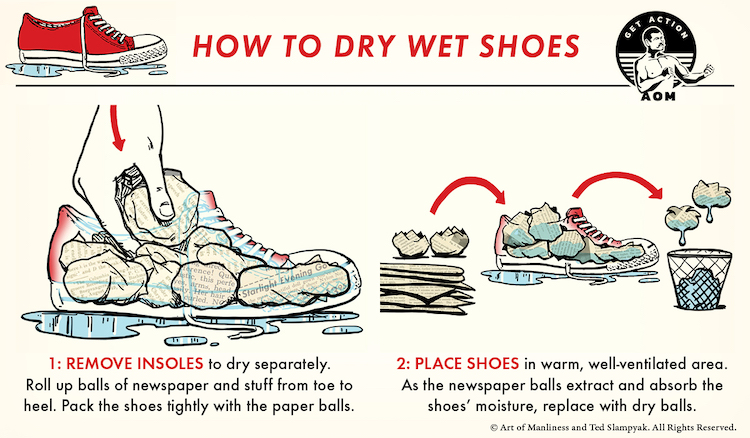Do you need to dry wet shoes quickly? Yes, there are several shoe drying methods you can use to speed up shoe drying. However, it’s important to avoid preventing shoe damage drying. This guide shows the best way to dry sneakers, how to dry running shoes, and drying shoes inside while avoiding common mistakes.

Image Source: content.artofmanliness.com
The Importance of Properly Drying Your Shoes
Leaving shoes wet can lead to several problems:
- Bacterial Growth: Wet environments encourage the growth of bacteria and fungi, leading to unpleasant odors and potentially causing skin infections like athlete’s foot.
- Material Damage: Prolonged moisture exposure can weaken the shoe’s materials, causing them to crack, warp, or disintegrate. This is especially true for leather, suede, and certain synthetic fabrics.
- Reduced Lifespan: Improper drying significantly shortens the lifespan of your shoes, forcing you to replace them more often.
- Discomfort: Wearing damp shoes is uncomfortable and can lead to blisters and other foot problems.
Prepping Your Shoes Before Drying
Before you even think about shoe drying methods, some simple prep work can significantly speed up shoe drying and remove moisture from shoes more effectively.
1. Remove Excess Water
Shake out as much water as possible. Turn the shoes upside down and give them a good shake over a sink or outside.
2. Take Out the Insoles and Laces
Remove the insoles and laces. These parts hold a lot of moisture and will dry much faster separately.
3. Clean Off Dirt and Debris
Use a soft brush or cloth to remove any dirt or debris from the shoes. Mud and grime can trap moisture and prolong the drying process.
4. Open the Shoes Fully
Loosen the laces as much as possible. Fully open the shoe to allow air to circulate inside.
Safe and Effective Shoe Drying Methods
Here are several shoe drying methods you can use to dry wet shoes quickly without drying shoes without shrinking or causing other prevent shoe damage drying.
1. Air Drying: The Gentle Approach
Air drying is the safest shoe drying method, minimizing the risk of damage. However, it’s also the slowest. Air drying shoes tips include:
- Location: Place your shoes in a well-ventilated area away from direct sunlight and heat. A shaded porch, a room with open windows, or a garage are good options.
- Air Circulation: Use a fan to increase air circulation around the shoes. This will speed up shoe drying time considerably.
- Patience: Air drying can take anywhere from 12 to 24 hours, or even longer depending on the humidity and the material of your shoes.
2. Newspaper or Paper Towels: Absorbing Moisture
This method utilizes the absorbent properties of paper to remove moisture from shoes.
- Stuffing: Crumple newspaper or paper towels and stuff them inside the shoes. Make sure to fill the toe box and heel area completely.
- Replacement: Replace the paper every few hours as it becomes damp. You’ll notice it absorbs a significant amount of moisture.
- Efficiency: This method is particularly effective for drying shoes inside, as it helps to absorb moisture from the inside out.
3. Rice: A Desiccant Alternative
Uncooked rice is a natural desiccant, meaning it absorbs moisture. This shoe drying method is great for shoes that are soaked.
- Submerge: Place the shoes in a container filled with uncooked rice, ensuring they are completely covered.
- Wait: Let the shoes sit in the rice for at least 12 hours, or longer if they are very wet.
- Clean Up: Brush off any rice grains that may have stuck to the shoes.
4. Shoe Dryer: A Specialized Tool
A shoe dryer is a device specifically designed to speed up shoe drying without damaging the materials. These dryers typically use gentle heat and airflow.
- Types: There are various types of shoe dryers available, including those that use heated air and those that use circulating air.
- Benefits: Shoe dryers are particularly useful for how to dry running shoes and other athletic footwear that get wet frequently.
- Usage: Follow the manufacturer’s instructions carefully to avoid overheating and damaging your shoes.
5. Using a Fan: Direct Airflow
A simple fan can significantly speed up shoe drying.
- Placement: Position the shoes in front of a fan, ensuring that air is circulating inside the shoes.
- Orientation: You can hang the shoes upside down from the fan using shoelaces or clips for better airflow.
- Time: This method can take several hours, but it’s generally faster than air drying alone.
Comparative Table of Shoe Drying Methods
| Method | Speed | Risk of Damage | Cost | Best For |
|---|---|---|---|---|
| Air Drying | Slow | Low | Free | All shoe types |
| Newspaper/Towels | Medium | Low | Low | Most shoe types |
| Rice | Medium | Low | Low | Submerged shoes |
| Shoe Dryer | Fast | Low-Medium | Medium | Athletic shoes, boots |
| Fan | Medium | Low | Low | Most shoe types |
Common Mistakes to Avoid When Drying Shoes
To prevent shoe damage drying, steer clear of these common pitfalls:
1. Direct Heat: A Recipe for Disaster
Avoid using direct heat sources such as:
- Hair Dryers: The high heat can melt adhesives, warp the shoe’s shape, and damage delicate materials.
- Radiators: Placing shoes directly on a radiator can cause the materials to dry out and crack.
- Direct Sunlight: Prolonged exposure to direct sunlight can fade colors and damage certain materials.
2. Washing Machines and Dryers: Not the Best Choice
While it might seem tempting, avoid putting your shoes in the washing machine or dryer unless the manufacturer specifically recommends it.
- Washing Machine: The harsh agitation and detergents can damage the shoe’s construction and materials.
- Dryer: The high heat can shrink, warp, and melt components of the shoe.
3. Ignoring the Material: One Size Doesn’t Fit All
Different shoe materials require different drying approaches.
- Leather: Avoid excessive heat and use leather conditioners to prevent drying and cracking.
- Suede: Use a suede brush to restore the nap after drying.
- Canvas: Air drying is generally the best option for canvas shoes.
- Synthetic Materials: Most synthetic materials can tolerate gentle heat, but avoid high temperatures.
4. Neglecting Internal Moisture: Drying From the Inside Out
Focus on drying the inside of the shoe as much as the outside. Stuffing with absorbent materials helps with remove moisture from shoes effectively.
5. Storing Damp Shoes: Inviting Problems
Never store shoes that are even slightly damp. This creates a breeding ground for bacteria and mold. Always ensure shoes are completely dry before storing them.
Specific Shoe Types: Tailoring Your Approach
Different types of shoes require slightly different drying techniques. Here’s how to approach some common shoe types:
How to Dry Running Shoes
- Remove Insoles and Laces: Essential for effective drying.
- Newspaper/Fan Combination: Stuff with newspaper to absorb moisture and use a fan for airflow.
- Shoe Dryer: A great option for frequent runners.
How to Dry Leather Shoes
- Air Dry: Avoid direct heat to prevent cracking.
- Shoe Trees: Use shoe trees to maintain the shoe’s shape while drying.
- Leather Conditioner: Apply leather conditioner after drying to replenish moisture.
How to Dry Suede Shoes
- Air Dry: Avoid direct heat.
- Suede Brush: Use a suede brush to restore the nap after drying.
- Suede Protector: Apply a suede protector to prevent future water damage.
How to Dry Canvas Shoes
- Air Dry: The best option to prevent shrinkage and damage.
- Gentle Cleaning: Clean any stains before drying to prevent them from setting.
After Drying: Finishing Touches
Once your shoes are dry, a few finishing touches can help maintain their condition and appearance:
- Leather Conditioning: Apply leather conditioner to leather shoes to replenish moisture and prevent cracking.
- Suede Brushing: Use a suede brush to restore the nap of suede shoes.
- Odor Removal: If your shoes still have an odor after drying, use a shoe deodorizer spray or sprinkle baking soda inside.
- Proper Storage: Store your shoes in a cool, dry place away from direct sunlight.
Frequently Asked Questions (FAQ)
Can I use a microwave to dry my shoes?
No, you should never use a microwave to dry your shoes. The microwave’s heat can damage the glue, warp the shoe’s shape, and even cause a fire.
What is the best way to dry sneakers?
The best way to dry sneakers is to remove the insoles and laces, stuff them with newspaper or paper towels, and place them in front of a fan or in a well-ventilated area.
How can I speed up shoe drying?
To speed up shoe drying, use a combination of methods, such as removing excess water, stuffing the shoes with absorbent materials, and using a fan or shoe dryer.
Is it safe to dry shoes on a radiator?
No, it is not safe to dry shoes on a radiator. The direct heat can damage the shoe’s materials and cause them to crack or warp.
What can I do to prevent shoe damage drying?
To prevent shoe damage drying, avoid using direct heat, washing machines, and dryers. Air drying and using absorbent materials are the safest methods.
How long does it take to remove moisture from shoes?
The time it takes to remove moisture from shoes depends on the shoe’s material, the amount of moisture, and the shoe drying method used. It can take anywhere from a few hours to a couple of days.
How effective is drying shoes inside?
Drying shoes inside can be effective, especially when using absorbent materials and a fan to circulate air. However, ensure the area is well-ventilated to prevent moisture buildup in the room.
Are there any special air drying shoes tips I should know?
Yes, some air drying shoes tips include placing the shoes in a well-ventilated area, using a fan to increase air circulation, and avoiding direct sunlight.
Can I use a dehumidifier to dry my shoes?
Yes, a dehumidifier can help speed up shoe drying, especially in humid environments. Place the shoes near the dehumidifier for best results.
By following these tips and avoiding common mistakes, you can dry wet shoes quickly and effectively, extending their lifespan and keeping your feet healthy and comfortable.

David Ruperto is a Footwear Engineer with expertise in 3D printing, design, and pattern making. With a background in Fine Arts from CUNY and training from SLEM and Cordwainer’s Savannah, he blends creativity with innovation. Based in New York, he shares his knowledge on BestForShoes.com, helping others explore the world of footwear.
